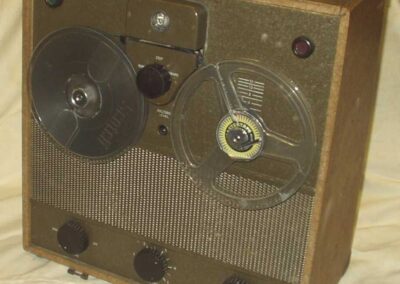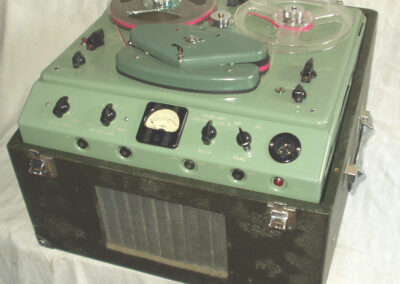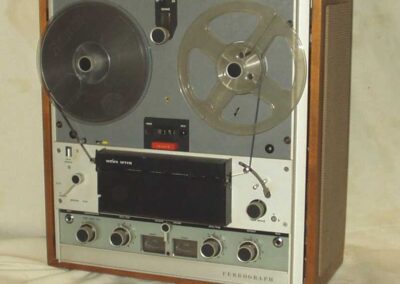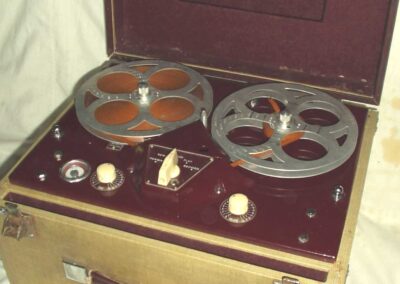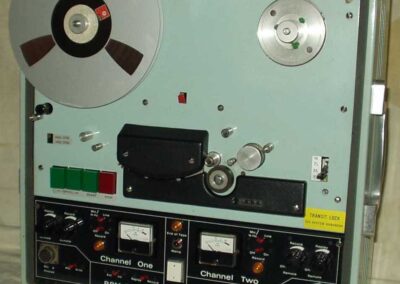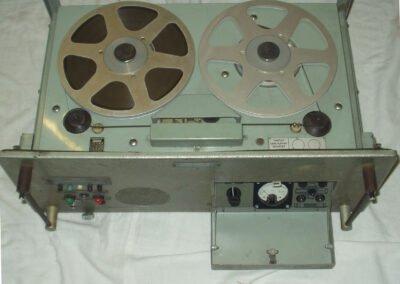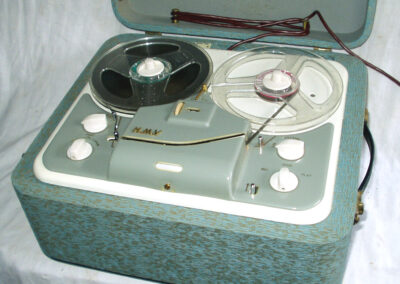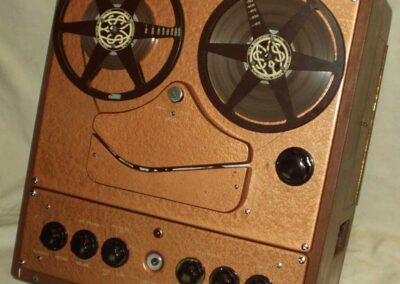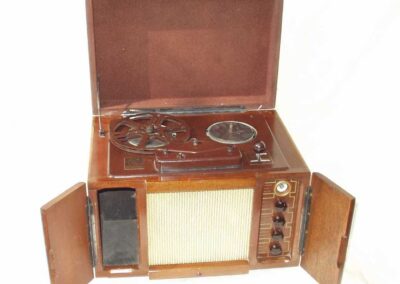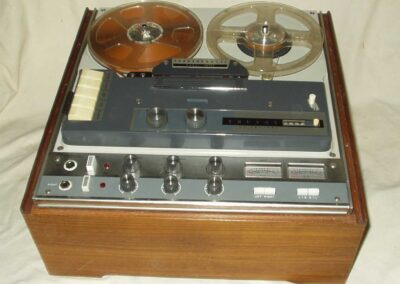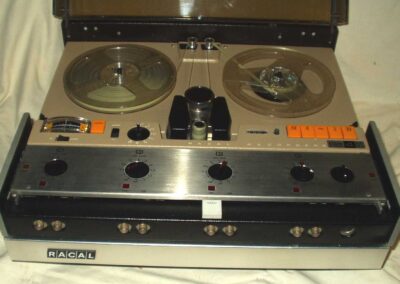‘A Guide to British tape-recorders’ is a fully illustrated, major work which traces the history and development of sound-recording, especially of the magnetic tape-recorder from the pioneering work by Valdemar Poulsen and his wire recorder, through the development of plastic based tape, to simple domestic-user models and the complex scientific, instrumentation and communication recorders of recent years. It also looks at the development of the associated tape, head and ancilliary components, recording the potted histories of the 100+ British tape-recorder and component makers, and their models.
It is hoped this work will encourage others to fully research their chosen companies before it is too late, just as I have for Brenell, Truvox, Thermionic Products, Racal… and have George West and Terry Martini on Ferrograph. Be warned, time is fast running out!
In the beginning
At the turn of the 20th century, the Danish telephone engineer, Valdemar Poulsen, pioneered the recording and retention of sound by electro-magnetic impulses onto wire. And so began the battle between Edison’s direct recording onto waxed cylinders and gramophone discs, and Poulsen’s onto steel wire or steel-ribbon; Poulsen had also prophesied magnetic oxide coated cards and paper media. But it was not until BASF in Germany had mastered the magnetic oxide coating of plastic tape in the 1930s, did tape-recording, as we know it, come to the fore. Meanwhile in Britain and America, much effort was being put into perfecting steel-wire or steel-ribbon recorders the more so as Semi Joseph Begun, a German pioneer of steel-ribbon recording had escaped Nazi Germany and joined Brush in the USA. The Allied Forces relied heavily on wire recorders during the war – American designs were license built in Britain by Boosey & Hawkes – but although the new plastic or paper based magnetic tape technology was no secret in the late 1930s, it took the clarity of supposedly ‘live’ broadcasts by the Nazi propaganda machine to awaken the allies to the very real advances made in Germany by BASF and AEG in magnetic tape-recording.
Led by M J Pulling of the BBC and E M Payne of EMI, an immediate post-war analysis of these pioneering German AEG ‘Magnetophons’ was undertaken for the British government in late-1945, opening the door to the development of magnetic tape-recorders in Britain by EMI for broadcasting and record production, by Scophony and Plessey for scientific use, and by GEC and RGD for ‘domestic’ use but it was not until 1948 that Thermionic Products began license building the first commercially viable domestic/business recorders – the Recordon dictating disc-recorder and the Brush Soundmirror, both developed by Semi Joseph Begun – that magnetic tape-recording became a commercial reality.
In 1948 there were only three British companies active in the tape-recorder market: Scophony, EMI and Thermionic Products. Then in 1949 Wright and Weaire (Ferrograph) entered the market and by 1950 there were some 17 companies offering everything from basic home-assembly kits to high quality professional recorders, many for cine-photography. By 1955 there were some 30 companies: tape had arrived and live studio recordings were now being mastered onto tape for reproduction onto disc. The days of direct disc-recording and optical recording to film had come to an end, forcing MSS (a leader in disc-recording) to turn to the manufacture of magnetic tape and professional tape-recorders.
When in 1955 Collaro, a famous gramophone maker, launched their brand new tape deck, it encouraged the major domestic audio companies to enter the market. Then in 1959 BSR (Collaro’s major competitor) launched their budget (and bomb-proof!) Monardeck causing a peak in 1960 with over 70 British tape-recorder brands, whose demand was boosted by the introduction of the affordable, 1/4-track heads, reducing the relative cost of tape but, above all, allowing the novelty of synchronised cine-film soundtracks and, with an auxiliary amplifier, stereophonic hi-fi to the masses through high quality pre-recorded tape-records from EMI, Columbia and others.
The makers
The burning question, “Which was the first British tape-recorder?” is not a simple one to answer. If we ignore the pre-war Blattnerphone and Marconi-Stille steel-ribbon recorders, the first British plastic-tape-recorder was announced in April 1947 by Plessey for scientific use: but little is known of this 4″ portable.
In 1947, EMI had developed their BTR1 studio recorder based on the German AEG Magnetophon, then in 1948 Thermionic Products launched their British-built 9″ magnetic oxide coated disc recorder, the ‘Recordon’ for dictation, followed by the new paper-tape ‘Soundmirror’, but both were licensed from Brush in the USA. Officially launched at the May 1949 Olympia show, the Soundmirror truly was the first British-built, complete tape-recorder, for although Wright & Weaire had demonstrated their prototype deck in October 1948, their first complete tape-recorder, the ‘Ferrograph’, did not come on stream until late 1949 by when RGD had also entered the market as had General Laminations with their ‘Sound Magnet’, using an unidentified tape deck, along with several others including Baird.
Meanwhile, in 1948 Scophony had been quietly developing a tape deck for the British government. Their first commercial model was launched in July 1949 as the Scophony-Baird ‘Cine-Soundmaster’ especially to synchronise sound to silent movies. This was followed in 1951 by their Scophony-Baird ‘Soundmaster’ domestic tape-recorder which offered the first direct competition to the Soundmirror.
By 1950 several new decks began to appear from the simplest and, frankly, quiet crudely designed kit-built decks, to complete and quite advanced models for quite diverse markets. At the bottom of the market were those aimed at radio enthusiasts who happily built kits to plan using parts supplied by High Street radio/electronic component dealers such as Stern, MOS, Premier and Garland – such dealers soon began offering complete tape-recorders using the new Lane deck, soon joined by the new Motek. Commercial and business users were offered various tape-recorders for dictation or answerphone/automatic dialers, while the professional user was offered models by Bradmatic, EMI and Leevers-Rich.
In 1951 came a new legal requirement for airfield to pilot communication recorders, a field soon dominated by Thermionic Products in the development of multi-track voice recorders. From this came airborne magnetic-tape based Flight Data Recorders for all commercial airliners and most military aircraft.
While the amateur market was well catered for, the domestic-user market remained quiet. This was understandable for Britain was still subject to rationing and tape was very expensive: besides, few saw any reason to replace their expensive gramophone collection. Most entertainment was after all found at local cinemas or dance halls; few sat at home listening to the radio or gramophone to pass the time away except after Sunday lunch and “Mrs Dale’s diary”.
However in 1953, Max Grundig launched his well built and specified German-made tape-recorders in Britain. These were aimed at the amateur cine-photographer to add sound to their films. The domestic-user market, now freed from rationing and buoyant with the Queen’s Coronation with demand for the new fangled television, saw the audio entertainment market take off and by 1954, famous names such as Ferrograph, Truvox and Brenell began dominating the quality domestic and semi-professional tape-recorder markets, albeit trailing well behind Grundig in sales!
The British domestic-user market rapidly expanded following Collaro’s new Transcriptor tape-deck of 1955, which allowed radio manufacturers to enter the market for the first time with an affordable proprietary deck – even if only to maintain their market share – but their excellent Transcriptor was replaced by the, arguably inferior, Studio in 1957 which soon faced stiff competitor from fellow turntable makers, Garrard (with their easy to load cartridge deck) and BSR’s inexpensive but remarkably robust Monardeck TD1 which led to a flood of new budget, badge-engineered tape-recorders entering the market, many contract built by Plessey for the home-catalogue market.
The early-mid 1960s were the hay-day of British tape-recording with a bewildering range of models – and enthusiasts’ magazines – but it was short lived for following the introduction by Philips of their incredibly versatile, easy to load ‘Compact Cassette’ in 1963 – which for the first time truly allowed music (albeit lo-fi) on the move – it soon decimated the global open-reel market and, along with more open trade with Japan, had by the end of the decade, destroyed the domestic open-reel market, along with much of the British tape-recorder industry.
While Garrard’s easy to load 1/4″ tape cartridge offered high fidelity, Philips ‘Compact Cassette’ offered an abominable low-fidelity but through wise marketing they now offered pre-recorded albums as ‘Musicassettes’ which could be played on a portable radio-cassette or in the car, even if the speed varied with the car’s and the cassette player had consumed the tape before journey’s end! But by the late 1960s, advances in technology, especially of tape formulations had brought acceptable hi-fi standards to the masses, sounding the death knell of the cumbersome and bulky open-reel tape-recorder. The utterly reliable Japanese models had rightly forced many substandard British brands off the market, indeed, by 1970 there were barely 30 British open-reel tape-recorder brands left – only a handful in the domestic-user market led by the Thorn group (with their superior high grade tape-deck), Truvox, Brenell and Ferrograph. Within five years their numbers had been reduced to barely 10, over half of which were now specialists in commercial voice logging, studio, instrumentation recording and air-borne Flight Data Recorders. Those few which survived, such as Brenell, Ferrograph and Leevers-Rich now concentrated on the professional, scientific and studio markets, only to fold with the universal adoption of digital recording in the 1980s.
Many of the 100+ British companies lasted barely 2 years – the average was 9-1/2 years; few lasted more than 20 years. Thermionic Products survived the longest, some 45 years, ending their time as Racal-Thermionic, later Racal Recorders, making multi-track voice loggers and instrumentation recorders: they even acquired the Zonal tape business and were the last to produce there own heads. They were the last in the business.
Tape decks
The term ‘Tape Deck’ was actually registered by Wright & Weaire, forcing others to use terms such as ‘tape-panel’ to describe the transport mechanism, until Truvox challenged the right to the now generic term, whereupon it passed into common usage.
In essence, a tape deck comprises a flat, rigid plate onto which were screwed heads, motors and control gear. The deck was invariably a 1/16″ to 1/8″ thick steel or aluminium alloy plate, but Bradmatic used a 3/4″ thick Tufnol phenolic-resin board, while Truvox used a 3/4″ furniture-grade plywood deck. These were perfectly stable for 1/4″ tape in domestic use, but wider tapes, especially 1″ for the demanding professional and industrial applications, caused considerable drag on the guides and heads which along with their sheer weight, caused flimsy decks to flex and track alignment to go awry. This was soon resolved by thicker cast-alloy sheets or fully webbed cast-alloy decks.
Motors were at first fractional-horse power jobs from gramophones (Garrard and Collaro) or small fans (BT-H/AEI). Most early decks used for simplicity three motors, often of single speed, but many opted for two speeds by manually swapping belt positions on pulleys, or using capstan sleeves for extra speeds. By the late 1960s professional decks were using superior hysteresis synchronous capstan motors from AEI in Britain or, more usually, Papst of Germany. Studio models, with their heavy 1″ tapes required more powerful motors and turned to direct drive capstan motors, some two-speed, but by the 1980s, studio models were increasingly using powerful computer controlled, twin capstan drive to handle the now standard 24-track, 2″ tapes.
Heads
Apart from the very few head makers such as Bradmatic, most heads were assembled in a quiet corner of the tape deck maker’s factory, using fly-pressed laminations, wound on a basic lathe or treadle. But soon, companies such as Wright and Weaire, Brenell and Truvox were offering their own full and half-track mono heads to others. Then independent head makers such as Marriott began to corner the domestic-user market – they produced for BSR – while engineers who had worked with Marriotts, now specialised in studio and multi-track heads such as Branch & Appleby and, later, Phi Magnetronics.
The arrival of 1/4 track was first met in Britain by the German ‘Miniflux’ head but by the early 1960s the Germany ‘Bogen’ head became dominant in the high-end domestic and professional markets.
Tape
Most early magnetic tape sold in Britain came from Scotch (3M of the USA) – after all they had pioneered tape production in America; this was widely branded or licensed to others, such as to Wright & Weaire and Pyral of France. Early tapes were robust paper-backed or fragile acetate based, but BASF used a superior PVC while the Americans turned to polyester.
The major British tape maker was EMI, closely followed by MSS, with their ‘Mastertape’, and Zonal (who began in the film industry – they later became Ilford-Zonal). Yet the pioneers of magnetic tape (BASF and their IG Farben sister, Agfa) were relative late comers to the British market mainly through trade restrictions. By then the Scotch formula has been adopted as standard by the American NAB and the BBC: ironically BASF now standardised on the ‘Scotch’ formula with their ‘LGS’ tape but clever marketing tactics soon saw BASF ousting EMItape as principal suppliers to British tape deck makers, reaping repeat sales. Excellent as their LGS tape was, their new LP35LH low noise/high fidelity tape of 1970 (formulated for cassettes) set new standards in audio performance and rapidly led to the demise of Britain’s EMItape, Mastertape and Zonal who now turned to the professional recording market.
With the move to digital hard disc recording, demand for new tape was now so low that the industry collapsed in the late 1990s; limited production resumed for the military and space programmes and in 2004, RMG restarted production of the former BASF/Agfa/Emtec formulations in professional matt-backed and glossy-backed ‘classic’ tapes. Computer data storage on tape is also proving far more stable in long term storage than solid state media, so tape’s future is looking more secure! So buy new tape, or lose it for ever!
Just as vinyl is making a rapid recovery, so too is analogue audio recording, valve amplifiers – even cassettes are enjoying a revival – so, hopefully, will open reel decks… one day.
Tape-recorder company histories include:
ACE, ACES, Alba, Amplion, Ariel Sound, Astronic, Baird, Bias, Bradmatic, Brenell, Bristol Cine, BAFC, BSR, Bush, Cadey, Casian, Cape, Chilton, Chitnis, Clarke & Smith, Collaro, Dansette, Dynatron, Editor (TRE), EKCO, Electromechs, Elizabethan, Elpico, EMI, Epsylon, EWA, Excel, Ferranti, Ferguson, Ferrograph, FiCord, Fidelity, Garrard, Gaumont-British, GBC, Gramdeck, Hartley, HMV, ITAM, JSR, Kenton, Kurland, Lane, Leevers-Rich, Lorlin, Magnavox, Marconiphone, Minivox, Motek, MSS, Murphy, Pamphonic, Penny & Giles, Perdio, Planet, Plessey, Portagram, PYE, Qualtape, Racal-Thermionic, RGD, Reflectograph, Reps, Regentone, Robuk, Scoptronics, SE Labs, Simon, Soundcraft Magnetics, Sound Master, Spectone, Studio Magnetics, TRD, TRE, Thermionic Products, Thorn Group, Trix, Trusound, Truvox, Ultra, Unitrack, Van der Molen, Verdik, Veritone, Vortexion, Waiter, Winstone, Wright & Weaire, Wayne Kerr, Wyndsor and many more.
“A Guide to British tape-recorders”
In two parts: 250+ b&w illustrations, 400+ pages A4 softback, 1st edition 2005, 2nd 2007, 3rd 2010, 4th 2011, 5th 2017
“Drawing on vintage advertising, reports, first hand accounts and many other historical facts, a useful and practical guide has resulted, and one that no serious collector of British audio tape recorders or historian can really do without. The fascinating history of the British tape recorder is presented here in all its glory”. Terry Martini, British Vintage Wireless Society
“I’ve been a tape recorder enthusiast for 50 years. I was amazed at what I learnt”. George West, Ferrograph.info
“A fascinating work, methodically and painstakingly researched” . PB

